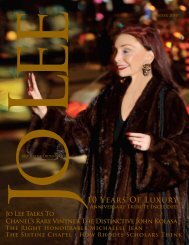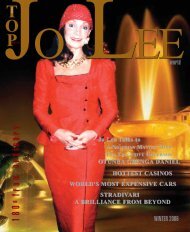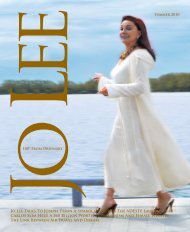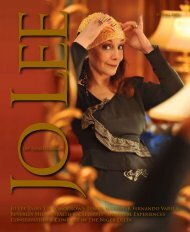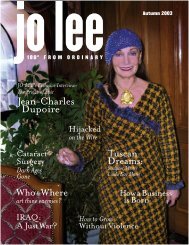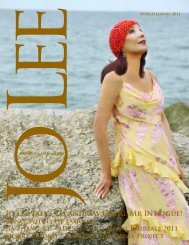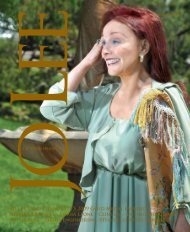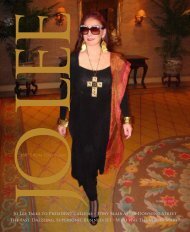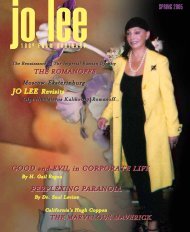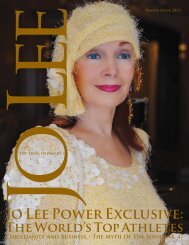WITS END - JO LEE Magazine
WITS END - JO LEE Magazine
WITS END - JO LEE Magazine
Create successful ePaper yourself
Turn your PDF publications into a flip-book with our unique Google optimized e-Paper software.
omanoff<br />
I first came to know of the Prince not as a young boy<br />
growing up at the English Royal Court at Windsor - but<br />
through one of the greats - a New York/San Francisco<br />
power mind whom over the years, has become one of my<br />
dear friends.<br />
Enamored with the inner elegance of Russia’s would-be<br />
Tsar, it was suggested to me during a recent stay in London<br />
how marvelous an interview with this remarkable<br />
gentleman would be.<br />
His name is Andrew Romanoff, grandnephew of Tsar<br />
Nicholas the 11 and: The Boy Who Would Be Tsar.<br />
phenomenal picture of his boyhood. A true masterpiece<br />
when one envisions THIS as somebody’s life!<br />
Educated at the military Imperial Service College, Andrew<br />
served in the British Navy during World War II.<br />
During this time, his ship, The HMS Sheffield, went<br />
to Murmansk and it was the very first time he had ever<br />
visited Russia.<br />
After the war in 1949 – Andrew sailed to the United<br />
States aboard a freighter with other thoroughbreds that<br />
he’d come to hold in high esteem - horses bound for the<br />
Kentucky Derby.<br />
The Prince, who has recently celebrated his 84th birthday,<br />
has become known as a distinguished artist with his<br />
drawings and paintings and now, his extraordinary writing.<br />
www.ptreyesbooks.com or griff@urbandigitalcolor.com<br />
The Boy Who Would Be Tsar is Prince Andrew’s first<br />
release as a Royal Personage – chronicling his amazing<br />
childhood - accompanied by his brilliant drawings of<br />
daily life as a child at Windsor Castle.<br />
“My grandfather, Grand Duke Alexander Michaelvich,<br />
was told that the Revolution was beginning and it was no<br />
longer safe for his family to remain in Russia.<br />
It was an emotional time for everyone. Grandfather went<br />
on ahead to assist with the arrangements. My grandmother,<br />
Grand Duchess Xenia {sister to the Tsar} would<br />
not leave unless all her retinue could come with her for<br />
they too, were in great danger. It was 1919. And King<br />
George V was coming to their rescue.<br />
The Grand Duchess’s mother, Dowager Empress Dagmar,<br />
Maria Theodorovna and my father and his brothers and<br />
sister along with their entire staff and teachers were<br />
brought on board the HMS Marlborough, leaving their<br />
lives in Russia for England and new beginnings. The<br />
King had given my family a Grace and Favor home on<br />
the grounds of Windsor Castle – the 23 room Frogmore<br />
Cottage with vast lawns, curving paths along the River<br />
Thames, fish ponds, polo fields and greenhouses full of<br />
exotic plants. It made for quite the upbringing.”<br />
The book is captivating.<br />
Andrew was born in 1923 in London and spent an impressive<br />
childhood behind the castle gates, speaking both<br />
English and Russian. "It was a strange atmosphere," he<br />
recalls. "I didn't know who the hell I was" and it is in his<br />
new autobiography, The Boy Who Would Be Tsar: The<br />
Art of Prince Andrew Romanoff, where he paints this<br />
Andrew<br />
In 1970, at the height of California’s Marin County hippie<br />
migration, Andrew became the owner of a West Marin<br />
company that made crystal and silver jewelry.<br />
"People get absorbed in the arc of his life," says San<br />
Francisco’s Gallery 16 owner, Griff Williams, an old<br />
friend of Andrew. "And it is an amazing tale.”<br />
But, in all the amazement over the Prince’s background,<br />
applause must also be given to the captivating quality of<br />
his ‘outsider art,’ a term used to describe artists often<br />
using unusual materials and techniques. The Prince’s<br />
whimsical art and miniature drawings are done in a medium<br />
originally intended as a children’s toy, a material<br />
called ‘Shrinky Dink’, where he paints on plastic sheets<br />
that shrink when baked in an oven. To the best of anyone's<br />
knowledge, there is no one else, save perhaps a<br />
generation of school kids, creating art with Shrinky<br />
Dinks.<br />
The original idea to do the book came from Mark Sloan,<br />
curator at the Charleston School of Art, who has done<br />
many books on Outsider Artists. The first mockup/and<br />
text was done by Mark with the Prince subsequently going<br />
to Griff Williams who redesigned and published the<br />
final edition as it is today. "His work is an object lesson<br />
for young artists," Griff Williams says. "He's so true to<br />
himself. He's so willing to let people in on even the most<br />
embarrassing moments of his life.”<br />
Andrew became an American citizen in 1956 and chooses<br />
to rarely use his royal title: His Serene Highness Andrew<br />
Romanoff. But ask anyone in town who knows him, and<br />
they'll tell you that he's a prince of a man. Quiet, modest<br />
to the point of seeming shy, he speaks in an indistinguishable<br />
accent that comes from growing up in London<br />
and speaking only Russian at home. ‘Yes, the Prince has<br />
this presence about him that's pretty wonderful.’<br />
While Andrew, a distant relative of Prince Charles, has<br />
led a storybook life, it is not without its tragedies.<br />
SUMMER 2007 <strong>JO</strong> <strong>LEE</strong> 19



